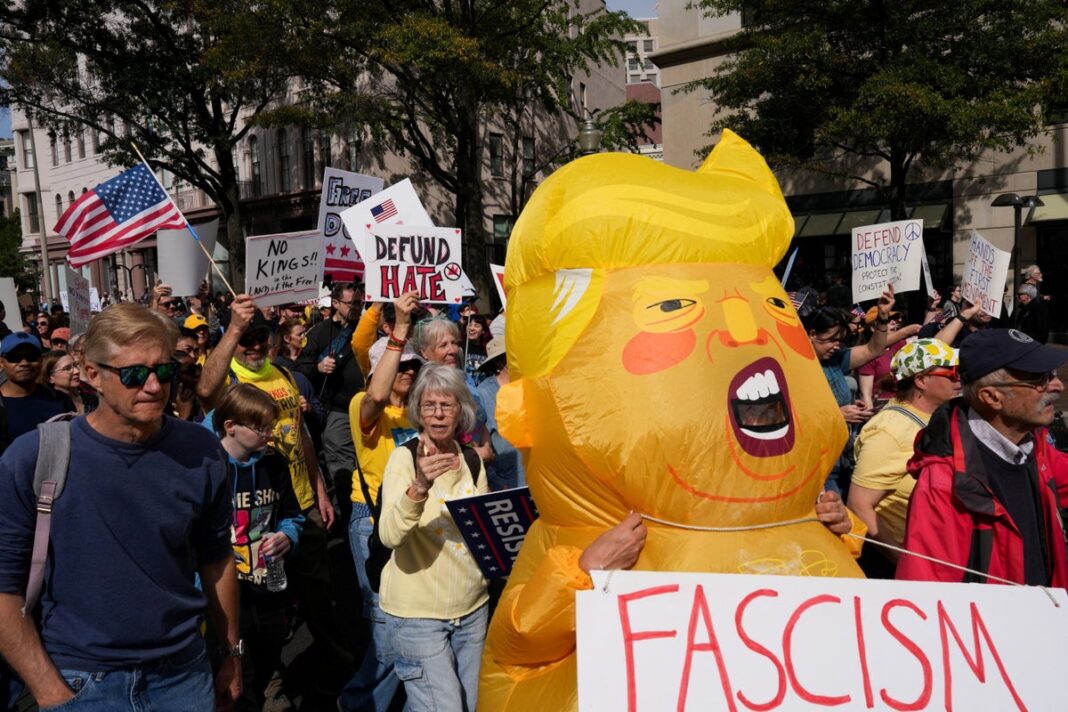No Kings Protests: A National Movement Against Authoritarianism
In a powerful display of citizens’ voices rising against what they perceive as authoritarian governance, the “No Kings” protests erupted across the United States on October 18, 2025. The protests, themed around the resistance to President Donald Trump’s leadership style, were not limited to the U.S.; rallies were also reported in cities like London and Madrid. This movement is characterized by public discontent over governmental issues, misinformation, and perceived power grabs by the Trump administration.
Historical Context and Background
The “No Kings” protests trace their origins to earlier unrest stemming from deep divisions in American politics. The inaugural protests in June 2025 saw more than 5 million individuals participating nationwide, driven by a collective anxiety surrounding the political climate. Organizers claim that Trump’s governance style resembles that of a monarch, thus justifying the protests aimed at reclaiming democratic values and asserting the rights of the populace. Current demonstrations aimed to build on the momentum from the first round, with organizers predicting even larger gatherings this time.
Protest Organizers and Their Message
A coalition of civil rights and advocacy groups, including Indivisible, spearheaded the protests, emphasizing that these gatherings embody the essence of American democracy. Ezra Levin, co-founder of Indivisible, articulated that “there is no greater threat to an authoritarian regime than patriotic people-power.” This statement encapsulates the central theme of the protests: a stand against perceived authoritarianism and a call for reclaiming democratic principles.
The protests also serve as a platform for various civil rights issues, showcasing unity among different factions advocating for reproductive rights, climate action, and other social issues. Many participants adopted the color yellow, symbolic of nonviolent resistance, akin to historical protests seen in Hong Kong and more recently in Ukraine. Organizers indicated that this bright color makes a visual statement against tyranny and signifies solidarity among protestors.
Government Response and Criticism
In response to the protests, Trump administration officials criticized the demonstrations and attempted to downplay their significance. Kevin Hassett, director of the National Economic Council, insisted that the president has made it clear he is not a king, deeming the protests nonsensical. Officials framed the gatherings as “Hate America rallies,” asserting that they were fueled by leftist agendas, particularly targeting Antifa.
Some state leaders, like Texas Governor Greg Abbott, took proactive measures by activating the National Guard ahead of the protests. Abbott referred to the Austin protest as “Antifa-linked,” invoking a narrative that justified a strong security presence, thereby potentially escalating tensions further.
Participation and Engagement
The turnout across the nation was unprecedented, with estimates suggesting participation in over 2,500 locations, highlighting widespread discontent. Major cities such as New York, Chicago, and Washington D.C. became focal points for demonstrators, flooding the streets with chants, signs, and proclamations against perceived government overreach. The atmosphere was electric, as thousands gathered to express their frustration over ongoing governmental issues, particularly the impact of the recent government shutdown.
Speakers at various rallies included prominent Democrats such as Senators Bernie Sanders and Raphael Warnock, who used the platform to underscore the urgency of these protests. Warnock addressed a crowd in Atlanta, urging attendees to be “deeply concerned” about Trump’s governing style, which he likened to authoritarianism. The participation of celebrities, activists, and political figures further amplified the movement’s visibility, encouraging a blend of grassroots and celebrity activism.
Visuals and Media Coverage
Social media played a crucial role in mobilizing the protests, with prominent hashtags trending online, urging people to join in. Visuals from the demonstrations vividly captured the fervor of the participants, with images showcasing vast crowds gathered in iconic locations such as Times Square in New York and near the U.S. Capitol. These scenes reflected not merely dissent but an assertion of collective identity against a backdrop of perceived despotism.
Reporters and photographers documented the diverse fabric of participants—young and old, various ethnic backgrounds, and a wide array of personal grievances converging into a united front. The media coverage was extensive, with news outlets highlighting the unexpected scale of the movement and the passionate speeches delivered at various rallies.
The Ongoing Discourse
The “No Kings” protests exemplify a burgeoning movement that resonates with many Americans feeling marginalized or disenfranchised by current political dynamics. As public discourse increasingly reflects polarization, these rallies can be seen as both a symptom and a reflection of broader societal issues at play. The ongoing engagement from everyday citizens, civil rights groups, and political leaders indicates that the conversation surrounding governance, democracy, and the future of U.S. politics remains vibrant and contentious.
Through these protests, a new chapter in American civic engagement is being written—one characterized by unity against authoritarianism and a steadfast commitment to democratic values.



